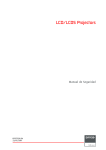Download SPARC Enterprise M8000/M9000 Servers Site Planning Guide
Transcript
SPARC Enterprise M8000/M9000 Servers Site Planning Guide Part No.: E23589-03 Manual Code: C120-H014-11EN October 2012 Copyright © 2007, 2012, Fujitsu Limited. All rights reserved. Oracle and/or its affiliates provided technical input and review on portions of this material. Oracle and/or its affiliates and Fujitsu Limited each own or control intellectual property rights relating to products and technology described in this document, and such products, technology and this document are protected by copyright laws, patents, and other intellectual property laws and international treaties. This document and the product and technology to which it pertains are distributed under licenses restricting their use, copying, distribution, and decompilation. No part of such product or technology, or of this document, may be reproduced in any form by any means without prior written authorization of Oracle and/or its affiliates and Fujitsu Limited, and their applicable licensors, if any. The furnishings of this document to you does not give you any rights or licenses, express or implied, with respect to the product or technology to which it pertains, and this document does not contain or represent any commitment of any kind on the part of Oracle or Fujitsu Limited, or any affiliate of either of them. This document and the product and technology described in this document may incorporate third-party intellectual property copyrighted by and/or licensed from the suppliers to Oracle and/or its affiliates and Fujitsu Limited, including software and font technology. Per the terms of the GPL or LGPL, a copy of the source code governed by the GPL or LGPL, as applicable, is available upon request by the End User. Please contact Oracle and/or its affiliates or Fujitsu Limited. This distribution may include materials developed by third parties. Parts of the product may be derived from Berkeley BSD systems, licensed from the University of California. UNIX is a registered trademark in the U.S. and in other countries, exclusively licensed through X/Open Company, Ltd. Oracle and Java are registered trademarks of Oracle and/or its affiliates. Fujitsu and the Fujitsu logo are registered trademarks of Fujitsu Limited. All SPARC trademarks are used under license and are registered trademarks of SPARC International, Inc. in the U.S. and other countries. Products bearing SPARC trademarks are based upon architectures developed by Oracle and/or its affiliates. SPARC64 is a trademark of SPARC International, Inc., used under license by Fujitsu Microelectronics, Inc. and Fujitsu Limited. Other names may be trademarks of their respective owners. United States Government Rights - Commercial use. U.S. Government users are subject to the standard government user license agreements of Oracle and/or its affiliates and Fujitsu Limited and the applicable provisions of the FAR and its supplements. Disclaimer: The only warranties granted by Oracle and Fujitsu Limited, and/or any affiliate of either of them in connection with this document or any product or technology described herein are those expressly set forth in the license agreement pursuant to which the product or technology is provided. EXCEPT AS EXPRESSLY SET FORTH IN SUCH AGREEMENT, ORACLE OR FUJITSU LIMITED, AND/OR THEIR AFFILIATES MAKE NO REPRESENTATIONS OR WARRANTIES OF ANY KIND (EXPRESS OR IMPLIED) REGARDING SUCH PRODUCT OR TECHNOLOGY OR THIS DOCUMENT, WHICH ARE ALL PROVIDED AS IS, AND ALL EXPRESS OR IMPLIED CONDITIONS, REPRESENTATIONS AND WARRANTIES, INCLUDING WITHOUT LIMITATION ANY IMPLIED WARRANTY OF MERCHANTABILITY, FITNESS FOR A PARTICULAR PURPOSE OR NON-INFRINGEMENT, ARE DISCLAIMED, EXCEPT TO THE EXTENT THAT SUCH DISCLAIMERS ARE HELD TO BE LEGALLY INVALID. Unless otherwise expressly set forth in such agreement, to the extent allowed by applicable law, in no event shall Oracle or Fujitsu Limited, and/or any of their affiliates have any liability to any third party under any legal theory for any loss of revenues or profits, loss of use or data, or business interruptions, or for any indirect, special, incidental or consequential damages, even if advised of the possibility of such damages. DOCUMENTATION IS PROVIDED “AS IS” AND ALL EXPRESS OR IMPLIED CONDITIONS, REPRESENTATIONS AND WARRANTIES, INCLUDING ANY IMPLIED WARRANTY OF MERCHANTABILITY, FITNESS FOR A PARTICULAR PURPOSE OR NON-INFRINGEMENT, ARE DISCLAIMED, EXCEPT TO THE EXTENT THAT SUCH DISCLAIMERS ARE HELD TO BE LEGALLY INVALID. Please Recycle Copyright © 2007, 2012, Fujitsu Limited. Tous droits réservés. Oracle et/ou ses sociétés affiliées ont fourni et vérifié des données techniques de certaines parties de ce composant. Oracle et/ou ses sociétés affiliées et Fujitsu Limited détiennent et contrôlent chacune des droits de propriété intellectuelle relatifs aux produits et technologies décrits dans ce document. De même, ces produits, technologies et ce document sont protégés par des lois sur le copyright, des brevets, d’autres lois sur la propriété intellectuelle et des traités internationaux. Ce document, le produit et les technologies afférents sont exclusivement distribués avec des licences qui en restreignent l’utilisation, la copie, la distribution et la décompilation. Aucune partie de ce produit, de ces technologies ou de ce document ne peut être reproduite sous quelque forme que ce soit, par quelque moyen que ce soit, sans l’autorisation écrite préalable d’Oracle et/ou ses sociétés affiliées et de Fujitsu Limited, et de leurs éventuels bailleurs de licence. Ce document, bien qu’il vous ait été fourni, ne vous confère aucun droit et aucune licence, expresses ou tacites, concernant le produit ou la technologie auxquels il se rapporte. Par ailleurs, il ne contient ni ne représente aucun engagement, de quelque type que ce soit, de la part d’Oracle ou de Fujitsu Limited, ou des sociétés affiliées de l’une ou l’autre entité. Ce document, ainsi que les produits et technologies qu’il décrit, peuvent inclure des droits de propriété intellectuelle de parties tierces protégés par copyright et/ou cédés sous licence par des fournisseurs à Oracle et/ou ses sociétés affiliées et Fujitsu Limited, y compris des logiciels et des technologies relatives aux polices de caractères. Conformément aux conditions de la licence GPL ou LGPL, une copie du code source régi par la licence GPL ou LGPL, selon le cas, est disponible sur demande par l’Utilisateur final. Veuillez contacter Oracle et/ou ses sociétés affiliées ou Fujitsu Limited. Cette distribution peut comprendre des composants développés par des parties tierces. Des parties de ce produit peuvent être dérivées des systèmes Berkeley BSD, distribués sous licence par l’Université de Californie. UNIX est une marque déposée aux États-Unis et dans d’autres pays, distribuée exclusivement sous licence par X/Open Company, Ltd. Oracle et Java sont des marques déposées d’Oracle Corporation et/ou de ses sociétés affiliées. Fujitsu et le logo Fujitsu sont des marques déposées de Fujitsu Limited. Toutes les marques SPARC sont utilisées sous licence et sont des marques déposées de SPARC International, Inc., aux États-Unis et dans d’autres pays. Les produits portant la marque SPARC reposent sur des architectures développées par Oracle et/ou ses sociétés affiliées. SPARC64 est une marque de SPARC International, Inc., utilisée sous licence par Fujitsu Microelectronics, Inc. et Fujitsu Limited. Tout autre nom mentionné peut correspondre à des marques appartenant à d’autres propriétaires. United States Government Rights - Commercial use. U.S. Government users are subject to the standard government user license agreements of Oracle and/or its affiliates and Fujitsu Limited and the applicable provisions of the FAR and its supplements. Avis de non-responsabilité : les seules garanties octroyées par Oracle et Fujitsu Limited et/ou toute société affiliée de l’une ou l’autre entité en rapport avec ce document ou tout produit ou toute technologie décrits dans les présentes correspondent aux garanties expressément stipulées dans le contrat de licence régissant le produit ou la technologie fournis. SAUF MENTION CONTRAIRE EXPRESSÉMENT STIPULÉE DANS CE CONTRAT, ORACLE OU FUJITSU LIMITED ET LES SOCIÉTÉS AFFILIÉES À L’UNE OU L’AUTRE ENTITÉ REJETTENT TOUTE REPRÉSENTATION OU TOUTE GARANTIE, QUELLE QU’EN SOIT LA NATURE (EXPRESSE OU IMPLICITE) CONCERNANT CE PRODUIT, CETTE TECHNOLOGIE OU CE DOCUMENT, LESQUELS SONT FOURNIS EN L’ÉTAT. EN OUTRE, TOUTES LES CONDITIONS, REPRÉSENTATIONS ET GARANTIES EXPRESSES OU TACITES, Y COMPRIS NOTAMMENT TOUTE GARANTIE IMPLICITE RELATIVE À LA QUALITÉ MARCHANDE, À L’APTITUDE À UNE UTILISATION PARTICULIÈRE OU À L’ABSENCE DE CONTREFAÇON, SONT EXCLUES, DANS LA MESURE AUTORISÉE PAR LA LOI APPLICABLE. Sauf mention contraire expressément stipulée dans ce contrat, dans la mesure autorisée par la loi applicable, en aucun cas Oracle ou Fujitsu Limited et/ou l’une ou l’autre de leurs sociétés affiliées ne sauraient être tenues responsables envers une quelconque partie tierce, sous quelque théorie juridique que ce soit, de tout manque à gagner ou de perte de profit, de problèmes d’utilisation ou de perte de données, ou d’interruptions d’activités, ou de tout dommage indirect, spécial, secondaire ou consécutif, même si ces entités ont été préalablement informées d’une telle éventualité. LA DOCUMENTATION EST FOURNIE « EN L’ÉTAT » ET TOUTE AUTRE CONDITION, DÉCLARATION ET GARANTIE, EXPRESSE OU TACITE, EST FORMELLEMENT EXCLUE, DANS LA MESURE AUTORISÉE PAR LA LOI EN VIGUEUR, Y COMPRIS NOTAMMENT TOUTE GARANTIE IMPLICITE RELATIVE À LA QUALITÉ MARCHANDE, À L’APTITUDE À UNE UTILISATION PARTICULIÈRE OU À L’ABSENCE DE CONTREFAÇON. Contents Preface 1. vii Physical Specification 1.1 Before Setting Up the System 1.2 Physical Specifications 1–4 Server Components 1.2.2 External Dimensions and Weights 1.2.3 Server Appearance 1.2.4 Server Installation (Space) 1–4 1–4 1–6 1–12 1.2.4.1 Size and Space Specifications 1.2.4.2 Footprints of the Cabinets 1.2.4.3 Free-Access Floor Openings for Underfloor Air Conditioning 1–28 1.2.4.4 Ceiling Height Access Route 1–12 1–21 1–30 1–31 Network Connection Specifications 2.1 1–1 1.2.1 1.2.5 2. 1–1 2–1 Planning Your Network Connection 2–1 2.1.1 Setup and Network Connections 2–2 2.1.2 Platform and Domain Setup Information 2.1.3 Selecting a System Control Network Configuration 2–3 2–3 v 2.2 3. UPS Controller 2.2.1 Overview 2–7 2.2.2 Signal Cables 2.2.3 Signal Line Configuration 2.2.4 Cable Connector 2–7 2–8 2–10 Environmental and Electrical Specifications 3.1 3.2 3.3 Environmental Requirements Index 3–1 3–1 3.1.1 Ambient Environmental Requirements 3.1.2 Recommended Ambient Temperature and Humidity 3.1.3 Contamination Specifications 3.1.4 Vibration Requirements Cooling Specifications 3–1 3–4 3–5 Cooling (Air-Conditioning) Requirements 3.2.2 Airflow and Heat Dissipation 3.2.3 Airflow Indicator Electrical Specifications 3–2 3–3 3.2.1 3–5 3–5 3–8 3–8 3.3.1 Single-Phase Power Supplies 3.3.2 Three-Phase Power Delta Supplies 3.3.3 Three-Phase Star Power Supplies 3.3.4 Circuit Breaker Capacity and Characteristics 3.3.5 Grounding 3.3.6 CPU Types and Server Maximum Power Consumption Abbreviations vi 2–7 3–10 3–16 3–20 3–23 3–25 Abbreviations–1 Index–1 SPARC Enterprise M8000/M9000 Servers Site Planning Guide • October 2012 3–25 Preface This site planning guide describes the physical, environmental, and electrical specification requirements of the SPARC Enterprise M8000/M9000 servers from Oracle and Fujitsu. References herein to the M8000 server or M9000 server are references to the SPARC Enterprise M8000 or SPARC Enterprise M9000 server. This chapter includes the following sections: ■ “Audience” on page vii ■ “Related Documentation” on page viii ■ “Text Conventions” on page ix ■ “Notes on Safety” on page ix ■ “Syntax of the Command-Line Interface (CLI)” on page x ■ “Documentation Feedback” on page x Audience This guide is written for experienced system administrators with working knowledge of computer networks and advanced knowledge of the Oracle Solaris Operating System (Oracle Solaris OS). vii Related Documentation All documents for your sever are available online at the following locations: Documentation Link Sun Oracle software-related manuals (Oracle Solaris OS, and so on) http://www.oracle.com/documentation Fujitsu documents http://www.fujitsu.com/sparcenterprise/manual/ Oracle M-series server documents http://www.oracle.com/technetwork/documentation/spa rc-mseries-servers-252709.html The following table lists titles of related documents. Related SPARC Enterprise M8000/M9000 Servers Documents SPARC Enterprise M8000/M9000 Servers Site Planning Guide SPARC Enterprise M8000/M9000 Servers Getting Started Guide* SPARC Enterprise M8000/M9000 Servers Overview Guide SPARC Enterprise M3000/M4000/M5000/M8000/M9000 Servers Important Legal and Safety Information * SPARC Enterprise M8000/M9000 Servers Safety and Compliance Guide External I/O Expansion Unit Safety and Compliance Guide SPARC Enterprise M8000/M9000 Servers Unpacking Guide* SPARC Enterprise M8000/M9000 Servers Installation Guide SPARC Enterprise M8000/M9000 Servers Service Manual External I/O Expansion Unit Installation and Service Manual SPARC Enterprise M3000/M4000/M5000/M8000/M9000 Servers Administration Guide SPARC Enterprise M3000/M4000/M5000/M8000/M9000 Servers XSCF User’s Guide SPARC Enterprise M3000/M4000/M5000/M8000/M9000 Servers XSCF Reference Manual SPARC Enterprise M4000/M5000/M8000/M9000 Servers Dynamic Reconfiguration (DR) User’s Guide SPARC Enterprise M4000/M5000/M8000/M9000 Servers Capacity on Demand (COD) User’s Guide SPARC Enterprise M3000/M4000/M5000/M8000/M9000 Servers Product Notes† SPARC Enterprise M8000/M9000 Servers Product Notes External I/O Expansion Unit Product Notes SPARC Enterprise M3000/M4000/M5000/M8000/M9000 Servers Glossary viii SPARC Enterprise M8000/M9000 Servers Site Planning Guide • October 2012 * This is a printed document. † Beginning with the XCP 1100 release. Text Conventions This manual uses the following fonts and symbols to express specific types of information. Font/Symbol Meaning Example AaBbCc123 What you type, when contrasted with on-screen computer output. This font represents the example of command input in the frame. XSCF> adduser jsmith AaBbCc123 The names of commands, files, and directories; on-screen computer output. This font represents the example of command output in the frame. XSCF> showuser -P User Name: jsmith Privileges: useradm auditadm Italic Indicates the name of a reference manual, a variable, or user-replaceable text. See the SPARC Enterprise M3000/M4000/M5000/M8000/M9000 Servers XSCF User’s Guide. "" Indicates names of chapters, sections, items, buttons, or menus. See Chapter 2, "System Features." Notes on Safety Read the following documents thoroughly before using or handling any SPARC Enterprise M8000/M9000 server. ■ SPARC Enterprise M3000/M4000/M5000/M8000/M9000 Servers Important Legal and Safety Information ■ SPARC Enterprise M8000/M9000 Servers Safety and Compliance Guide Preface ix Syntax of the Command-Line Interface (CLI) The command syntax is as follows: ■ A variable that requires input of a value must be put in Italics. ■ An optional element must be enclosed in []. ■ A group of options for an optional keyword must be enclosed in [] and delimited by |. Documentation Feedback If you have any comments or requests regarding this document, go to the following websites: ■ For Oracle users: http://www.oracle.com/goto/docfeedback Include the title and part number of your document with your feedback: SPARC Enterprise M8000/M9000 Servers Site Planning Guide, part number E23589-02 ■ For Fujitsu users: http://www.fujitsu.com/global/contact/computing/sparce_index.html x SPARC Enterprise M8000/M9000 Servers Site Planning Guide • October 2012 C H A PT E R 1 Physical Specification This chapter describes what the reader is expected to know, including physical specification for the SPARC Enterprise M8000/M9000 servers, before planning server installation. This chapter contains the following sections: 1.1 ■ Section 1.1, “Before Setting Up the System” on page 1-1 ■ Section 1.2, “Physical Specifications” on page 1-4 Before Setting Up the System Before starting server installation, verify that the requirements listed in TABLE 1-1 are satisfied. TABLE 1-1 Checklist Requirements Item Check System components Have the server components been decided? ❏ Has the total number of servers been decided? ❏ Have the system administrators and operators taken the necessary training courses?? ❏ System management 1-1 TABLE 1-1 Checklist (Continued) Requirements Item Check Physical specifications Has the server installation location been decided? ❏ Does the installation floor layout satisfy the ventilation and maintenance access requirements? See Section 1.2.4, “Server Installation (Space)” on page 1-12 ❏ Does the device layout guarantee that heated air vented from one device does not enter an air intake of another device? See Section 1.2.4, “Server Installation (Space)” on page 1-12 ❏ Does the access route provide sufficient space for transport of the packed server cabinets? Have you confirmed that all route incline angles are within the permitted range? See Section 1.2.5, “Access Route” on page 1-31 ❏ If a pallet jack is to be used, have you confirmed that the cabinet weight is within the load limit of the pallet jack? See Section 1.2.5, “Access Route” on page 1-31 ❏ If an elevator is to be used, have you confirmed that the elevator car is wide enough for the cabinet to be carried into it and that the cabinet weight is within the load limit of the elevator? See Section 1.2.5, “Access Route” on page 1-31 ❏ Network specification Do you clearly understand what data connections and feeds are required for system startup and network connections? See CHAPTER 2, “Network Connection Specifications” on page 2-1 ❏ Environmental specifications Does the computer room air handling meet temperature and humidity requirements? See Section 3.1, “Environmental Requirements” on page 3-1 ❏ Can the computer room continuously satisfy environmental requirements? ❏ Is the computer room adequately equipped to extinguish a fire? ❏ Is the computer room secured? ❏ Access route 1-2 SPARC Enterprise M8000/M9000 Servers Site Planning Guide • October 2012 TABLE 1-1 Checklist (Continued) Requirements Item Check Facility power Do you know the required operating voltages and electrical current levels of the server and peripherals? See Section 3.3, “Electrical Specifications” on page 3-8 ❏ Are enough power outlets provided for the server cabinet, monitors, and peripherals? ❏ Are the circuit breakers for the server suitable in terms of voltage and currentcarrying capacities? See Section 3.3, “Electrical Specifications” on page 3-8 ❏ If you use single-phase power feed, is a power outlet located within 3.0 meters (9.8 ft) of the server? ❏ Chapter 1 Physical Specification 1-3 1.2 Physical Specifications This section outlines the M8000/M9000 server components and lists their physical specifications. 1.2.1 Server Components TABLE 1-2 lists the names, the capacities and functions of the M8000/M9000 server components. TABLE 1-2 Names and Quantities Name Capacity/Function M8000 server Accommodates up to four CMUs [up to 16 CPU modules: (32 cores for SPARC64 VI processors, 64 cores for SPARC64 VII/SPARC64 VII+ processors)] and up to four IOUs. M9000 server (base cabinet) Accommodates up to eight CMUs [up to 32 CPU modules: (64 cores for SPARC64 VI processors, 128 cores for SPARC64 VII/SPARC64 VII+ processors)] and up to eight IOUs. M9000 server (expansion cabinet) Accommodates up to eight CMUs [up to 32 CPU modules: (64 cores for SPARC64 VI processors, 128 cores for SPARC64 VII/SPARC64 VII+ processors)] and up to eight IOUs. Rack-mountable dual power feed Provides power redundancy (with single-phase dual power feed) for an M8000 server. Optional. Power cabinet There are two types of power cabinet: • Provides three-phase dual power feed for an M8000 server • Provides single-phase dual power feed or three-phase dual power feed for an M9000 server One power cabinet is required for each M8000 server. One power cabinet is required for each M9000 server of the base or expansion cabinet type. (The single-phase dual power feed for the M9000 server is optional.) 1.2.2 Remarks The M9000 server, when combined with an expansion cabinet can accommodate up to 16 CMUs [up to 64 CPU modules: (128 cores for the SPARC64 VI processor, 256 cores for the SPARC64 VII/ SPARC64 VII+ processors)] and up to 16 IOUs. External Dimensions and Weights TABLE 1-3 lists the external dimensions and weights of the M8000/M9000 server cabinets. 1-4 SPARC Enterprise M8000/M9000 Servers Site Planning Guide • October 2012 TABLE 1-3 Installation Specifications (External Dimensions and Weights) External Dimensions [mm (inch)] Name Width Depth Height Weight [kg] M8000 server 750 (29.5) 1260 (49.6) 1800 (70.9) 700** M8000 + power cabinet 1054 (41.5) 1260 (49.6) 1800 (70.9) 1020** M9000 server (base cabinet) 850 (33.5) 1260 (49.6) 1800 (70.9) 940 M9000 (base cabinet) + power cabinet 1154 (45.4) 1260 (49.6) 1800 (70.9) 1290 M9000 (base cabinet + expansion cabinet) 1674 (65.9)† 1260 (49.6) 1800 (70.9) 1880 M9000 (base cabinet + expansion cabinet) + power cabinet 2282 (89.8)† 1260 (49.6) 1800 (70.9) 2580 Rack-mountable dual power feed* 489 (19.3) 1003 (39.5) 278 (10.9) [6U] 75 Power cabinet 317 (12.5)‡ 1244 (49.0) 1800 (70.9) 350 * The Rack-mountable dual power feed can only be mounted on the equipment rack. † When combining a base cabinet and an expansion cabinet, the width of each cabinet is 837 mm (including the exterior side panels). ‡ The width of a power cabinet includes the exterior side panel. **The weight of a server does not include the weight of optional hardware. Chapter 1 Physical Specification 1-5 1.2.3 Server Appearance FIGURE 1-1 to FIGURE 1-6 show each appearance of M8000/M9000 server components. M8000 Server Appearance FIGURE 1-1 M8000 Server Front 1-6 Rear SPARC Enterprise M8000/M9000 Servers Site Planning Guide • October 2012 FIGURE 1-2 M8000 Server + Power Cabinet Front Rear Chapter 1 Physical Specification 1-7 M9000 Server Appearance FIGURE 1-3 M9000 Server (Base Cabinet) Front 1-8 Rear SPARC Enterprise M8000/M9000 Servers Site Planning Guide • October 2012 FIGURE 1-4 M9000 Server (Base Cabinet + Expansion Cabinet) Front Rear Chapter 1 Physical Specification 1-9 FIGURE 1-5 M9000 Server (Base Cabinet + Power Cabinet) Rear Front 1-10 SPARC Enterprise M8000/M9000 Servers Site Planning Guide • October 2012 FIGURE 1-6 M9000 Server (Base Cabinet + Expansion Cabinet + Power Cabinet) Front Rear Chapter 1 Physical Specification 1-11 1.2.4 Server Installation (Space) The M8000/M9000 server is intended to be used in a computer room. 1.2.4.1 Size and Space Specifications Before beginning an M8000/M9000 server installation, secure a service area (maintenance area) that is large enough for each cabinet plus required service access space for each component. FIGURE 1-7 to FIGURE 1-16 show the space required for installation of each server. M8000 Server Installation Area FIGURE 1-7 M8000 Server Installation Area 1260 (49.6) 800 (31.5) M8000 2860 (112.6) 800 (31.5) Service area Service area 750(29.5) Unit: mm (inch) Front 1-12 SPARC Enterprise M8000/M9000 Servers Site Planning Guide • October 2012 M8000 Server + Power Cabinet Installation Area M8000 800 (31.5) Power cabinet 800 (31.5) Service area 1260 (49.6) 2860 (112.6) FIGURE 1-8 Service area 1054 (41.5) Unit: mm (inch) Front Note – Before mounting units in an M8000 server equipment rack, secure the service areas as shown in FIGURE 1-9 or FIGURE 1-10. Chapter 1 Physical Specification 1-13 FIGURE 1-9 M8000 Server (With an Equipment Rack) Installation Area 750 (29.5) 1260 (49.6) M8000 2860 (112.6) 800 (31.5) Service area 800 (31.5) Service area 1550 (61.0) Front 1-14 SPARC Enterprise M8000/M9000 Servers Site Planning Guide • October 2012 Unit: mm (inch) FIGURE 1-10 M8000 Server (With an Equipment Rack) + Power Cabinet Installation Area 1054 (41.5) 2860 (112.6) 800 (31.5) M8000 1260 (49.6) Power cabinet 800 (31.5) Service area Service area Unit: mm (inch) 1854 (73.0) Front Note – Before mounting units in an M8000 server equipment rack at a location where no space can be secured on the right side of the server, secure the service areas as shown in FIGURE 1-11 or FIGURE 1-12. Chapter 1 Physical Specification 1-15 FIGURE 1-11 M8000 Server (With an Equipment Rack) Installation Area 1260 (49.6) 1200 (47.2) M8000 3260 (128.3) 800 (31.5) Service area Service area 750 (29.5) Front 1-16 SPARC Enterprise M8000/M9000 Servers Site Planning Guide • October 2012 Unit: mm (inch) M8000 Server (With an Equipment Rack) + Power Cabinet Installation Area 1054 (41.5) 1200 (47.2) 3260 (128.3) M8000 1260 (49.6) Power cabinet 800 (31.5) Service area 800 (31.5) FIGURE 1-12 Service area 317 (12.5) 737 (29.0) Unit: mm (inch) Front Chapter 1 Physical Specification 1-17 M9000 Server Installation Area FIGURE 1-13 M9000 Server (Base Cabinet) Installation Area 1260 (49.6) 900 (35.4) M9000 (Base cabinet) 3060 (128.3) 900 (35.4) Service area Service area 850 (33.4) Unit: mm (inch) Front 1-18 SPARC Enterprise M8000/M9000 Servers Site Planning Guide • October 2012 M9000 Server (Base Cabinet) + Power Cabinet Installation Area 1260 (49.6) 900 (35.4) M9000 (Base cabinet) 3060 (128.3) 900 (35.4) Service area Power cabinet FIGURE 1-14 317 (12.5) Service area 837 (33.0) 1154 (45.3) Unit: mm (inch) Front Chapter 1 Physical Specification 1-19 FIGURE 1-15 M9000 Server (Base Cabinet + Expansion Cabinet) Installation Area 3060 (128.3) M9000 (Ex. cabinet) 900 (35.4) M9000 (Base cabinet) 1260 (49.6) 900 (35.4) Service area Service area 837 (33.0) Unit: mm (inch) 1674 (65.9) Front 1-20 SPARC Enterprise M8000/M9000 Servers Site Planning Guide • October 2012 M9000 Server (Base Cabinet + Expansion Cabinet) + Power Cabinet Installation Area 3060 (128.3) M9000 (Ex. cabinet) 900 (35.4) M9000 (Base cabinet) Power cabinet Power cabinet 900 (35.4) Service area 1260 (49.6) FIGURE 1-16 317 (12.5) Service area 824 (32.4) Unit: mm (inch) 2282 (89.8) Front 1.2.4.2 Footprints of the Cabinets FIGURE 1-17 to FIGURE 1-22 show the bottom of the M8000/M9000 server cabinets, such as the openings for laying cables, air inlet ports used for cooling, legs, and casters. The views in these figures are transparent (see-through) views of the bottom surface of the server as seen from directly above the top of the server. The values indicated are layout values of the cabinet. If its feet are fixed to the floor, size difference (±2 mm/±0.08 inches) must be take into consideration to designate its location. The bottom of the server is at about 90 mm (about 3.4 inches) from the floor surface. Chapter 1 Physical Specification 1-21 M8000 Server Footprint FIGURE 1-17 M8000 Server Footprint Front Caster : 113 mm (4.5 inches) in maximum outer diameter (Maximum diameter when rotating the caster by 360 degrees) Feet : 66 mm (2.6 inches) in diameter Attached to the server by using M20 Opening for cables inlet and outlet Opening for air inlet Unit: mm (inch) 1-22 SPARC Enterprise M8000/M9000 Servers Site Planning Guide • October 2012 FIGURE 1-18 M8000 Server + Power Cabinet Footprint for Three-phase power feed Front Opening for cables inlet and outlet: 36.4 mm (1.4 inches) in diameter Caster : 113 mm (4.5 inches) in maximum outer diameter (Maximum diameter when rotating the caster by 360 degrees) Feet : 66 mm (2.6 inches) in diameter Attached to the server by using M20 Opening for cables inlet and outlet Opening for air inlet Unit: mm (inch) Chapter 1 Physical Specification 1-23 M9000 Server Footprint FIGURE 1-19 M9000 Server (Base Cabinet) Footprint Front Caster : 113 mm (4.5 inches) in maximum outer diameter (Maximum diameter when rotating the caster by 360 degrees) Feet : 66 mm (2.6 inches) in diameter Attached to the server by using M20 Opening for cables inlet and outlet Opening for air inlet Unit: mm (inch) 1-24 SPARC Enterprise M8000/M9000 Servers Site Planning Guide • October 2012 FIGURE 1-20 M9000 Server (Base Cabinet) + Power Cabinet Footprint for Three-phase power feed for Single-phase power feed Front Opening for cables inlet and outlet: 36.4 mm (1.4 inches) in diameter Caster : 113 mm (4.5 inches) in maximum outer diameter (Maximum diameter when rotating the caster by 360 degrees) Feet : 66 mm (2.6 inches) in diameter Attached to the server by using M20 Opening for cables inlet and outlet Opening for air inlet Unit: mm (inch) Chapter 1 Physical Specification 1-25 FIGURE 1-21 M9000 Server (Base Cabinet + Expansion Cabinet) Footprint Front Caster : 113 mm (4.5 inches) in maximum outer diameter (Maximum diameter when rotating the caster by 360 degrees) Feet : 66 mm (2.6 inches) in diameter Attached to the server by using M20 Opening for cables inlet and outlet Opening for air inlet Unit: mm (inch) 1-26 SPARC Enterprise M8000/M9000 Servers Site Planning Guide • October 2012 FIGURE 1-22 M9000 Server (Base Cabinet + Expansion Cabinet) + Power Cabinet Footprint for Three-phase power feed for Single-phase power feed for Three-phase power feed for Single-phase power feed Front Opening for cables inlet and outlet: 36.4 mm (1.4 inches) in diameter Caster : 113 mm (4.5 inches) in maximum outer diameter (Maximum diameter when rotating the caster by 360 degrees) Feet : 66 mm (2.6 inches) in diameter Attached to the server by using M20 Opening for cables inlet and outlet Opening for air inlet Unit: mm (inch) Chapter 1 Physical Specification 1-27 1.2.4.3 Free-Access Floor Openings for Underfloor Air Conditioning Use underfloor air conditioning to cool the M9000 server (with an expansion cabinet). To use underfloor air conditioning, air-conditioning openings must be provided on the freeaccess floor under the cabinet. FIGURE 1-23 and FIGURE 1-24 show examples of floor openings. There must be four openings of sizes corresponding to the recommended value for underfloor air-conditioning. However, if these openings cannot be prepared, use the largest possible floor openings that can be prepared in the raised floor under the cabinet or in the area around the cabinet, after taking into consideration such factors as the air-conditioning capacity required for the cabinet, the floor strength, and the locations of the leveling feet. 1-28 SPARC Enterprise M8000/M9000 Servers Site Planning Guide • October 2012 FIGURE 1-23 M9000 Server (Base Cabinet + Expansion Cabinet) Floor Openings Front Caster : 113 mm (4.5 inches) in maximum outer diameter (Maximum diameter when rotating the caster by 360 degrees) Feet : 66 mm (2.6 inches) in diameter Unit: mm (inch) Chapter 1 Physical Specification 1-29 FIGURE 1-24 M9000 Server (Base Cabinet + Expansion Cabinet) + Power Cabinet Footprint Front Caster : 113 mm (4.5 inches) in maximum outer diameter (Maximum diameter when rotating the caster by 360 degrees) Feet : 66 mm (2.6 inches) in diameter Unit: mm (inch) 1.2.4.4 Ceiling Height The minimum ceiling height for the M8000/M9000 server is 2.3m (7.5 ft), measured from the true floor or a raised floor, whichever is higher. The space above the server and its surroundings must not restrict the movement of cooling air between the air conditioner and the server. The space above the server and its surroundings must not restrict the following: ■ ■ 1-30 The movement of cooling air between the air conditioner and the bottom of the server The movement of the hot air coming out of the top of the server SPARC Enterprise M8000/M9000 Servers Site Planning Guide • October 2012 1.2.5 Access Route This section describes necessary considerations before you move the server to its installation destination. The access route must satisfy the requirements listed in TABLE 1-4. Each cabinet is packed with simple packaging or in a wood-framed case for shipping of the server. If it is difficult to carry the packed cabinet to the installation destination, remove the packing materials, front and rear doors, side panels, and/or other parts as necessary. If the cabinet weight exceeds the minimum withstand load for the transport equipment used, you can move the cabinet with its PSU and FAN unit (about 4 kg each) removed. Also, confirm that the access route is free of any steps and other obstacles that would expose the cabinet to shock. TABLE 1-4 Name M8000 server M9000 server (Base cabinet) (Expansion cabinet) Space Required for Transport Status During Transport Minimum Door Height [mm (inch)] Minimum Door Width [mm (inch)] Minimum Passage Width [mm (inch)] Minimum Elevator Car Depth [mm (inch)] Minimum Withstand Load of Transport Equipment [kg] ‡ Simple packaging* 1900 (74.8) 1000 (39.4) 1200 (47.2) 1500 (59.0) 820 10 Without front and rear doors or side panels 1900 (74.8) 800 (31.5) 1000 (39.4) 1350 (53.1) 690 10 Tri-Wall† 2100 (82.7) 1800 (70.9) 1800 (70.9) 1100 (43.3) 830 10 Wooden† packing 2100 (82.7) 1900 (74.8) 1900 (74.8) 1100 (43.3) 980 10 Simple packaging* 1900 (74.8) 1100 (43.3) 1300 (51.2) 1500 (59.0) 950 10 Without front and rear doors or side panels 1900 (74.8) 900 (35.4) 1100 (43.3) 1350 (53.1) 820 10 Tri-Wall† 2100 (82.7) 1800 (70.9) 1800 (70.9) 1200 (47.2) 1050 10 Wooden† packing 2100 (82.7) 1800 (70.9) 1800 (70.9) 1200 (47.2) 1100 10 Chapter 1 Maximum Inclination of Access Route [° ] Physical Specification 1-31 TABLE 1-4 Name Power cabinet Space Required for Transport (Continued) Status During Transport Minimum Door Height [mm (inch)] Minimum Door Width [mm (inch)] Minimum Passage Width [mm (inch)] Minimum Elevator Car Depth [mm (inch)] Minimum Withstand Load of Transport Equipment [kg] ‡ Simple packaging* 1900 (74.8) 700 (27.6) 900 (35.4) 1500 (59.0) 350 10 Without front and rear doors or side panels 1900 (74.8) 700 (27.6) 900 (35.4) 1350 (53.1) 320 10 Tri-Wall† 2100 (82.7) 1600 (63.0) 1600 (63.0) 1200 (47.2) 450 10 Wooden† 2100 (82.7) 1700 (67.0) 1700 (67.0) 1200 (47.2) 500 10 Maximum Inclination of Access Route [° ] packing * Simple packaging means a cabinet is covered only with a packing material such as a vinyl sheet instead of being packed in a wood-framed case or a cardboard box. † When in Tri-Wall and wooden packing, use the pallet jack to move the cabinet. ‡ The transport equipment includes the elevator and pallet jack used to transport the cabinet. 1-32 SPARC Enterprise M8000/M9000 Servers Site Planning Guide • October 2012 C H A PT E R 2 Network Connection Specifications This chapter describes the network connection specifications of the M8000/M9000 servers. 2.1 ■ Section 2.1, “Planning Your Network Connection” on page 2-1 ■ Section 2.2, “UPS Controller” on page 2-7 Planning Your Network Connection This section provides an overview for starting the M8000/M9000 server network required for system startup and network connections. For details on the connections, see the SPARC Enterprise M8000/M9000 Servers Installation Guide. 2-1 FIGURE 2-1 M8000/M9000 Server Connection Schematic Diagram of Interface Cables Basic equipment M8000/M9000 LAN port (x2) Serial port XSCFU (x2) USB RCI-IF Option 10Base-T/100Base-T(TX) Serial interface USB device (maintenance port) RCI interface (external power supply control unit) IOU (M8000: Max 4) (M9000: Max 16) PCI card x8 UPC interface (x2) 2.1.1 SCSI/LAN/WAN interface Fibre Channel Serial Adapter UPS (Uninterruptible Power Supply) Setup and Network Connections The serial port of the eXtended System Control Facility unit (XSCFU) is used for the following purposes: ■ Connecting a local area network (LAN) port to the system administration network ■ Monitoring the boot process ■ Changing the initial values of the system controller The administration network connects the XSCFU to the system administrator's management console. A direct connection can be used for this purpose. However, the connection is usually one through a hub or switch specific to the system control network. To initialize a LAN port, direct administration of the serial port must be performed. 2-2 SPARC Enterprise M8000/M9000 Servers Site Planning Guide • October 2012 2.1.2 Platform and Domain Setup Information The following information is required for installation of the M8000/M9000 servers: ■ ■ ■ ■ ■ ■ Host name IP address Domain Netmask IP address of the network gateway IP address of the network name server In addition, the following network connections must be available: ■ ■ ■ One serial console connection (9600 baud, N81) One 10/100BASE-T Ethernet connection for XSCF (connected to Port 0) One 10/100BASE-T Ethernet connection for each domain Note – The XSCF Ethernet port is IEEE 802.3i and IEEE 802.3u compliant. This requires auto-negotiation for the port into which it terminates. 2.1.3 Selecting a System Control Network Configuration Consider the following when determining the system control network configuration: ■ An IP address appropriate to the existing environment can be assigned to each LAN port, and the Class B private address, which is the default address, can be changed. ■ Either dual power feed or single power feed must be selected for the power feed option of your server. ■ The customer may segregate the LAN port or network for access by field engineers. Or the field engineer access may be through the serial port in the event that maintenance is required. Generally, there are three server control network configurations as follows, according to installation conditions: ■ XSCF Configuration A (Basic Configuration) ■ XSCF Configuration B (Restricted Redundancy) ■ XSCF Configuration C (Maximum Redundancy) Chapter 2 Network Connection Specifications 2-3 XSCF Configuration A (Basic Configuration) Only one of the two LAN ports is used. The serial port and the other LAN port are reserved so that they can be used as maintenance ports. The same switch is used for system administration and the remote service. Consequently, any failure of the switch causes a failure of the server control network. FIGURE 2-2 XSCF Configuration A (Basic Configuration) ETHERNET #0 ETHERNET #1 Switch Serial port Remote service Firewall System administration 2-4 SPARC Enterprise M8000/M9000 Servers Site Planning Guide • October 2012 XSCF Configuration B (Restricted Redundancy) Both LAN ports are used. One port is used for system administration, and the other is used for the remote message function. If one switch fails, errors can be reported. The serial port and port for the remote service switch can be used as maintenance ports. FIGURE 2-3 XSCF Configuration B (Restricted Configuration) ETHERNET #0 Switch Maintenance port ETHERNET #1 Serial port Switch System administration Remote service Firewall Chapter 2 Network Connection Specifications 2-5 XSCF Configuration C (Maximum Redundancy) Both LAN ports are used. Each switch has maintenance ports, which are used for the remote service or system administration. The switches are connected for failure management and system administration. If a switch fails, no interrupt occurs in the system control network. FIGURE 2-4 XSCF Configuration C (Maximum Configuration) ETHERNET #0 ETHERNET #1 Serial port Switch Switch System administration Remote service Firewall Maintenance port 2-6 SPARC Enterprise M8000/M9000 Servers Site Planning Guide • October 2012 2.2 UPS Controller This appendix explains the UPS controller (UPC), which controls an uninterruptible power supply unit (UPS). 2.2.1 Overview A UPS unit is used to provide a stable supply of power to the system in the event of a power failure or an extensive power interruption. When a failure is detected in the supply of power, an error can be reported to the server through the signal cable connection between a UPC port on the server and a UPS that has the UPC interface, so that the server can execute emergency shutdown processing to safely shut down the system. 2.2.2 Signal Cables Prepare shielded and paired cables that have the following specifications: ■ DC resistance (roundtrip/1 pair): 400 Ω/km or less ■ Cable length: Up to 10 m (33 ft.) Chapter 2 Network Connection Specifications 2-7 2.2.3 Signal Line Configuration This section describes signal line definitions and configuration when connected to a UPS. FIGURE 2-5 shows the signal line configuration when connected to a UPS. TABLE 2-1 defines these signal lines. FIGURE 2-5 Connection with UPS and the Server 7 *BTL 6 *BPS/*UALM 9 *ACOFF 5 SG 1 UPS TABLE 2-1 UPS cable Server Signal Line Definitions Signal Name Definitions Pin Number *BPS/*UAL M Signal indicates faulty UPS conditions. 6 Normal: OFF Failure: ON *BTL Signal provides a warning of a low battery level and a pending UPS failure. 7 Normal: OFF Warning: ON (Note 1) 2-8 SPARC Enterprise M8000/M9000 Servers Site Planning Guide • October 2012 Remarks TABLE 2-1 Signal Line Definitions (Continued) Pin Number Signal Name Definitions *ACOFF Signal indicates power failure at the commercial AC supply connector to the UPS. 9 SG Signal ground 5 ER Signal indicates the main unit is running (Equipment Ready). 1 Remarks Normal: OFF Power failure: ON (Note 2) Do not connect to ER signal pin. ON: Indicates contacts are closed. OFF: Indicates contacts are open. Note 1: Use a UPS that can normally supply power from the battery for at least 10 to 60 seconds after *BTL is turned on. Note 2: Use a UPS that can normally supply power f from the battery even if *ACOFF does not turn on in the event of an instantaneous power failure lasting two seconds or less. Chapter 2 Network Connection Specifications 2-9 2.2.4 Cable Connector The UPS cable specifications are as follows: ■ Connector type D-SUB9 pin Male (install side: Female) DEU-9PF-F0 ■ Terminal array FIGURE 2-6 identifies pin signals of the UPC port and the UPS cable. Do not use the unused pins (pin number 2, 3, 4 and 8 in the FIGURE 2-6). The pins on the cable side are as follows. FIGURE 2-6 Corresponding Terminals in UPC Connector and the UPS Cable UPC port side Pin # UPS cable Signal name 1 ER 2 --- 3 --- 4 --- 5 SG (Note) 6 *BPS/*UALM 7 *BTL 8 9 --- SG *BTL *ACOFF *BPS/*UALM *ACOFF Note: Do not connect to the ER signal pin. Note – If you need UPC cables, make arrangements separately. For details, contact your sales representatives. 2-10 SPARC Enterprise M8000/M9000 Servers Site Planning Guide • October 2012 C H A PT E R 3 Environmental and Electrical Specifications This chapter explains environmental and electrical power supply specifications and conditions necessary for stable system operation: 3.1 ■ Section 3.1, “Environmental Requirements” on page 3-1 ■ Section 3.2, “Cooling Specifications” on page 3-5 ■ Section 3.3, “Electrical Specifications” on page 3-8 Environmental Requirements This section describes ambient environmental and vibration requirements for M8000/M9000 servers. 3.1.1 Ambient Environmental Requirements The M8000/M9000 servers must satisfy the ambient environmental requirements listed in TABLE 3-1. 3-1 TABLE 3-1 Environmental Requirements Operating Range Non-Operating Range Optimum Ambient temperature 5°C to 32°C (41°F to 89.6°F) Unpacked: 0°C to 50°C (32°F to 122°F) Packed: -20°C to 60°C (-4°F to 140°F) 21°C to 23°C (70°F to 74°F) Relative humidity* 20% RH to 80% RH to 93% RH 45% RH to 50% RH Altitude restriction† 3,000 m (10,000 ft) 12,000 m (40, 000 ft) Temperature conditions 5°C to 32°C (41°F to 89.6°F) : 0 to less than 1500 m (0 to less than 4921 ft) 5°C to 30°C (41°F to 86°F) : 1500 m to less than 2000 m (4921 ft to less than 6562 ft) 5°C to 28°C (41°F to 82.4°F) : 2000 m to less than 2500 m (6562 ft to less than 8202 ft) 5°C to 26°C (41°F to 78.8°F) : 2500 m to 3000 m (8202 ft to 9843 ft) * There is no condensation regardless of the temperature and humidity. † All altitudes are above sea level. 3.1.2 Recommended Ambient Temperature and Humidity Keep the temperature in the computer room at a comfortable level for people or slightly lower. This temperature level can prevent inadequate cooling of sections of the computer room which can be due to heat generated by a device or by trapped hot air. Keeping the computer room at a comfortable level can reduce related adverse effects on each device in the entire system configuration. Special consideration must be paid to humidity if underfloor ventilation is used. Normally, air contains water vapor. Relative humidity, which is indicated as a percentage (%) of the total amount of water vapor that can exist in the air without condensing, is inversely proportional to air temperature; it goes down when the temperature rises, and goes up when the temperature drops. For example, air with a relative humidity of 45% at a temperature of 24°C (75°F) has a relative humidity of 65% at a temperature of 18°C (64°F); and if the temperature drops farther, the relative humidity rises to more than 65%, eventually to condense out as water droplets. 3-2 SPARC Enterprise M8000/M9000 Servers Site Planning Guide • October 2012 Air conditioning facilities usually do not provide functions to precisely monitor and control the temperature and humidity throughout an entire computer room. Generally, computer room air conditioning controls the temperature and humidity according to the monitoring data at individual points corresponding to multiple exhaust vents in the main unit and other units in the room. However, since air conditioning facilities for underfloor ventilation perform such control according to the monitoring data at each point close to an exhaust vent, the distribution of the temperature and humidity across the entire computer room is uneven. TABLE 3-2 lists the recommended temperature and humidity values for computer rooms. TABLE 3-2 Recommended Temperature and Humidity Values for Computer Rooms Point Close to Underfloor Exhaust Vent Monitoring and Control Point in Room Remarks Temperature Humidity Temperature [°C] [°F] [%] [°C] [°F] [%] Direct blowing or duct blowing - - - 24 ±2 75 ±4 45 ±5 - Underfloor ventilation 18 ±1 64 ±2 65 ±5 Target temperature of 24°C Target temperature of 75°F About 45% at 24°C The room temperature and humidity fluctuate, without control, according to the thermal load in the room. Direct blowing or using duct blowing and underfloor ventilation together 18 ±1 64 ±2 65 ±5 24 ±2 75 ±4 45 ±5 - Air Conditioning Method 3.1.3 Humidity Contamination Specifications The allowable contaminations in the M8000/M9000 servers are listed in TABLE 3-3. Chapter 3 Environmental and Electrical Specifications 3-3 TABLE 3-3 3.1.4 Specifications (Allowable Contamination) Contamination Tolerable Limit Hydrogen sulfide (H2S) Up to 7.1 ppb Sulfur dioxide (sulfur oxide) (SO2) Up to 37 ppb Hydrogen chloride (HCI) Up to 6.6 ppb Chlorine (CI2) Up to 3.4 ppb Hydrogen fluoride (HF) Up to 3.6 ppb Nitrogen dioxide (nitrogen oxide) (NO2) Up to 52 ppb Ammonia (NH3) Up to 420 ppb Ozone (O3) Up to 5 ppb Oil vapor Up to 0.2 mg/m3 Dust Up to 0.15 mg/m3 Seawater (salt damage) The installation site shall not be within 0.5 km of the ocean or coastal areas (unless the computer room uses air conditioners to filter out airborne sea salt particles from outside air). Vibration Requirements The allowable vibrations in the M8000/M9000 servers are listed in TABLE 3-4. TABLE 3-4 Specifications (Allowable Vibration) Allowable Vibration [gal] Name Operating Non-Operating M8000 server M9000 server 250* 400*, † * Allowable vibration (Oracle and Fujitsu standards) for artificially generated seismic waves. † The value for non-operation is applicable when vibration-proofing measures are taken for the leveling feet. 3-4 SPARC Enterprise M8000/M9000 Servers Site Planning Guide • October 2012 3.2 Cooling Specifications This section describes cooling specifications for M8000/M9000 servers. 3.2.1 Cooling (Air-Conditioning) Requirements TABLE 3-5 lists the cooling and air-conditioning requirements for each server component. TABLE 3-5 Specifications (Cooling and Air-Conditioning Requirements) Heat Dissipation [kJ/h] Exhaust Airflow [cmm(m3/m)] Cooling Method Air-Conditioning Type Noise Level [dBA] M8000 server 1396837800* 94 Overfloor/underfloor Forced air cooling 67 M9000 server (base cabinet) 2232072792* 102 Overfloor/underfloor Forced air cooling 68 M9000 server (base cabinet + expansion cabinet) 42912145584* 205 Underfloor‡ Forced air cooling 69 Rack-mountable dual power feed -† -† Overfloor/underfloor Forced air cooling -† Power cabinet ( for M8000 server) -† -† Overfloor/underfloor Forced air cooling -† Power cabinet (for M9000 server base cabinet) -† -† Overfloor/underfloor Forced air cooling -† Power cabinet (for M9000 server base cabinet + expansion cabinet) -† -† Underfloor‡ Forced air cooling -† Name * Heat dissipation varies by power consumption. Determine the power consumption based on the actual system configuration and then confirm the right value. † The heat dissipation, exhaust airflow and acoustic noise value of the power cabinet is included in the value for the M8000 server or M9000 server. ‡ At an installation altitude ranging from 0 to less than 400 m (1312 ft) above sea level, you can select overfloor cooling as the cooling method of the server. 3.2.2 Airflow and Heat Dissipation Since the M8000/M9000 server is designed to be cooled by forced air convection, sufficient airflow throughout the entire system must be generated. To satisfy the requirements listed below, the installation space requirements listed in Section 1.2.4, “Server Installation (Space)” on page 1-12 must be observed. Chapter 3 Environmental and Electrical Specifications 3-5 Any other equipment installed around the system must not block any of the service areas, or intake and exhaust air vents. ■ The M8000 server uses internal fans to generate a total airflow of 94 cubic meters per minute (3320 cubic feet per minute [cfm]) under normal operating conditions. ■ The M9000 server uses internal fans in the base cabinet and expansion cabinet, and it generates a total airflow of 102 cubic meters per minute (3600 cubic feet per minute [cfm]) under normal operating conditions. ■ The M8000 server and rack-mountable dual power feed system draws air from the bottom of the cabinet and exhausts it at the top and rear. FIGURE 3-1 Front 3-6 Cooling Air and Exhaust Flows of M8000 Server and Rack-mountable Dual Power Feed Side SPARC Enterprise M8000/M9000 Servers Site Planning Guide • October 2012 Rear ■ The M9000 server draws air from the bottom of the cabinet and exhausts it at the top. FIGURE 3-2 Rear ■ Cooling Air and Exhaust Flows of M9000 Server Side Front The power cabinet draws air from the front of the cabinet and exhausts it at the rear. FIGURE 3-3 Front Cooling Air and Exhaust Flows of Power Cabinet Side Chapter 3 Environmental and Electrical Specifications 3-7 3.2.3 Airflow Indicator The airflow indicator indicates the amount of air exhausted from the server while the M8000/M9000 servers are up and running. The values do not include the peripheral devices. To display the amount of exhaust air, use the showenvironment air command. XSCF> showenvironment air Air Flow:5810CMH Note – The showenvironment air command displays the calculated airflow based on the fan speed such as Low speed or High speed etc. The fan speed is displayed by the showenvironment Fan command. For details of the showenvironment(8) command, refer to the man page. For installation details of the M8000/M9000 servers, see the SPARC Enterprise M8000/M9000 Servers Installation Guide. You can also obtain the exhaust air data using the SNMP agent function. To obtain the data of exhaust air using the SNMP agent function, install the latest XSCF extension MIB definition file to the SNMP manager. For details on the XSCF extension MIB definition file, see the SPARC Enterprise M3000/M4000/M5000/M8000/M9000 Servers XSCF User’s Guide. 3.3 Electrical Specifications This section describes the power supply requirements for system operation. Obtain the appropriate power supply after confirming the power requirements for the system to be installed. M8000/M9000 servers can use two types of power supply: single-phase power and threephase power. Redundant power cords are supported only on servers that have the dual power feed option. The dual power feed option is included by default on servers that are configured for three-phase power. Note – Power cords are not redundant on single power feed servers without the dual power feed option. On servers that have single power feed, all power cords must be connected and powered on at all times. 3-8 SPARC Enterprise M8000/M9000 Servers Site Planning Guide • October 2012 Note – With the dual power feed option, all wiring connected to the server is used to supply power, and the load is balanced at 50%/50%. Note that even if an extremely low load compromises the load balancing, it will not affect operation. TABLE 3-6, TABLE 3-8 and TABLE 3-9 list the power requirements for single-phase and three- phase power supplies. Note – The values of power consumption represent power requirements of the system under highest achieved stress and utilization, including environmental conditions. Contact your service engineer for the applicable power requirements. See the SPARC Enterprise M8000/M9000 Servers Overview Guide for some examples of power consumption. Chapter 3 Environmental and Electrical Specifications 3-9 3.3.1 Single-Phase Power Supplies TABLE 3-6 lists the power requirements for the M8000/M9000 servers and the rack-mountable dual power feed which is used for the dual power feed option and the power cabinet. Note – In the event of a fault or power failure in the power system of the M8000/M9000 server, the rack-mountable dual power feed and the power cabinet supply power to the M8000/M9000 server using a single power feed. To achieve this, the dual power feed and the power cabinet have the capability equal to the power requirements for the M8000/M9000 servers. In normal operations, power is supplied from both feeds within the range of power consumption of the M8000/M9000 server. TABLE 3-6 Specifications (Single-Phase Power Requirements) Power Supply Voltage [V] Name Phase Single Frequency [Hz] 50/60 +2%, -4% Power Consumption [kW] Apparent Power [kVA] 3.88-10.50* Power Factor Leakage Current [mA] 4.1110.98* 0.9 or higher 100 or less† 4.1 or less† 30‡ 6.20-20.22* 6.5821.45* 0.9 or higher 100 or less† 4.1 or less† 30‡ 12.6442.89* 0.9 or higher 100 or less† 4.1 or less† 30‡ M8000 server 200 to 240 VAC ±10% Rack-mountable dual power feed (for M8000 server) Equivalent to the M8000 server M9000 server (base cabinet) 200 to 240 VAC ±10% Power cabinet (for M9000 server base cabinet) Equivalent to the M9000 server (base cabinet) M9000 server (base cabinet + expansion cabinet) 200 to 240 VAC ±10% Power cabinet (for M9000 server base cabinet + expansion cabinet) Equivalent to the M9000 server (base cabinet + expansion cabinet) 3-10 Single Single 50/60 +2%, -4% 50/60 +2%, -4% 11.92-40.44* Circuit Breaker Capacity [A] Rush Current [A0-p] SPARC Enterprise M8000/M9000 Servers Site Planning Guide • October 2012 * Maximum power consumption and apparent power vary by the type of CPU mounted. To plan the installation of a server equipped with different types of CPU, use the CPU of larger power consumption as a basis. For the types of CPU, see Section 3.3.6, “CPU Types and Server Maximum Power Consumption” on page 3-25. † This value represents the current for each cable. ‡ This value represents the capacity of a system main line switch for each power supply of the single-phase power supplies. Chapter 3 Environmental and Electrical Specifications 3-11 FIGURE 3-4 and FIGURE 3-5 show the single-phase power supply connections. FIGURE 3-4 Single-Phase Power Supply Connections (M8000 Server) M8000 Input #22 #21 #20 Input #2 #1 #0 CB CB CB CB CB CB Power feed B distribution board (200-240 VAC) Power feed A distribution board (200-240 VAC) Note – Connect the power feed A and the power feed B (for dual-power feed) to a separate AC power supply from each other. Note – To connect power cords for this system directly to your power distribution board, the power cords must be connected on a one-to-one basis as shown in the above figure. 3-12 SPARC Enterprise M8000/M9000 Servers Site Planning Guide • October 2012 FIGURE 3-5 Single-Phase Power Supply Connections (M9000 Server) (Base cabinet) Dual power feed system (Expansion cabinet) Base cabinet Expansion cabinet Dual power feed system Input Input #0 #1 #2 #3 #4 #10 #11 #12 #13 #14 In put Input #24 #34 #23 #33 #22 #32 #21 #31 #20 #30 CB CB CB CB Power feed A distribution board (200-240 VAC) CB CB CB CB Power feed A distribution board (200-240 VAC) CB CB CB CB CB CB CB CB CB CB CB CB Power feed B distribution board (200-240 VAC) Power feed B distribution board (200-240 VAC) Note – Connect the power feed A and the power feed B (for dual-power feed) to a separate AC power supply from each other. Note – To connect power cords for this system directly to your power distribution board, the power cords must be connected on a one-to-one basis as shown in the above figure. Chapter 3 Environmental and Electrical Specifications 3-13 Power Cord Connection Specifications TABLE 3-7 lists specifications for single-phase power supply connections. The M8000/M9000 servers are equipped with the required number of single-phase power cords. TABLE 3-7 Specifications (Single-Phase Power Supply Connections) Power Cord Length* Destination M8000 server Japan 3.0 m (9.8 ft) 30A-250V 3P, locking type (NEMA L6-30P) 3 (single power feed) 6 (dual power feed) 30A-250V 3P, locking type (NEMA L6-30R) Embedded type: 3320-L6 <American Denki> Exposed type: 3321-L6 <American Denki> North America General overseas 3.0 m (9.8 ft) NEMA L6-30P 3 (single power feed) 6 (dual power feed) NEMA L6-30R (North America only) Europe 3.0 m (9.8 ft) EN60309 (32A) 3 (single power feed) 6 (dual power feed) EN60309 (32A) 3-14 Plug Geometry Number of Plugs Name SPARC Enterprise M8000/M9000 Servers Site Planning Guide • October 2012 Outlet in Facility TABLE 3-7 Specifications (Single-Phase Power Supply Connections) (Continued) Power Cord Length* Number of Plugs Name Destination Plug Geometry Outlet in Facility M9000 server Japan 3.0 m (9.8 ft) 30A-250V 3P, locking type (NEMA L6-30P) (Base cabinet) 5 (single power feed) 10 (dual power feed) (Base cabinet + expansion cabinet) 10 (single power feed) 20 (dual power feed) 30A-250V 3P, hook type, locking (NEMA L6-30R) Embedded type: 3320-L6 <American Denki> Exposed type: 3321-L6 <American Denki> North America General overseas 3.0 m (9.8 ft) NEMA L6-30P† (Base cabinet) 5 (single power feed) 10 (dual power feed) (Base cabinet + expansion cabinet) 10 (single power feed) 20 (dual power feed) NEMA L6-30R (North America only) Europe 3.0 m (9.8 ft) EN60309 (32A) (Base cabinet) 5 (single power feed) 10 (dual power feed) (Base cabinet + expansion cabinet) 10 (single power feed) 20 (dual power feed) EN60309 (32A) * The power cord length is the length from the cable port on the cabinet to the outlet plug. Chapter 3 Environmental and Electrical Specifications 3-15 † Plugs for the North American and general overseas markets must be replaced locally in accordance with local electrical standards as required. Make sure that a qualified electrician performs the replacement work. Note – For the servers that have the plug with lock function, confirm that a 30A overcurrent protection device is available outside the server. If one is not available, prepare an external 30A overcurrent protection that can be achieved by means of no-fuse breakers (NFBs) or fuses. The plug with lock function refers to plugs other than grounding-type ones with two parallel blades, such as the NEMA L6-30, L6-20, L6-15, and L5-15. 3.3.2 Three-Phase Power Delta Supplies Three-phase power of the M8000/M9000 servers is supplied by the power cabinet. TABLE 3-8 lists the power requirements of the power cabinet for the three-phase power supply. Note – The power cabinet is provided with dual power feed and supplies power to the M8000/M9000 server. In the event of a fault or power failure in one power feed, the other supplies the power which is equal to the power consumption. In normal operations, power is supplied from both feeds within the range of power consumption of the power cabinet. TABLE 3-8 Specifications (Three-Phase Delta Power Requirements) Power Supply Name Power cabinet (for M8000 server) Power cabinet (for M9000 server base cabinet) 3-16 Voltage [V] Phase 200 to 240 VAC ± 10% Threephase delta Frequency [Hz] 50/60 +2%, -4% Power Consumption [kW] Apparent Power [kVA] 3.88-10.50* 6.20-20.22* Circuit Breaker Capacity [A] Power Factor Rush Current [A0-p] Leakage Current [mA] 4.1110.98* 0.9 or higher 100 or less† 30 or less† 50‡ 6.5821.45* 0.9 or higher 170 or less† 40 or less† 80‡ SPARC Enterprise M8000/M9000 Servers Site Planning Guide • October 2012 TABLE 3-8 Specifications (Three-Phase Delta Power Requirements) (Continued) Power Supply Name Power cabinet (for M9000 server base cabinet + expansion cabinet) Voltage [V] Phase 200 to 240 VAC ± 10% Threephase delta Frequency [Hz] 50/60 +2%, -4% Power Consumption [kW] Apparent Power [kVA] 11.92-40.44* 12.6442.89* Power Factor Rush Current [A0-p] Leakage Current [mA] 0.9 or higher 170 or less† 40 or less† Circuit Breaker Capacity [A] 80‡ * Maximum power consumption and apparent power vary by the type of CPU mounted. To plan the installation of a server equipped with different types of CPU, use the CPU of larger power consumption as a basis. For the types of CPU, see Section 3.3.6, “CPU Types and Server Maximum Power Consumption” on page 3-25. † This value represents the current for each cable. ‡ This value represents the capacity of a system main line switch for each power supply of the single-phase power supplies. Chapter 3 Environmental and Electrical Specifications 3-17 FIGURE 3-6 shows the three-phase delta power supply connections for M8000/M9000 servers. FIGURE 3-6 Three-Phase Delta Power Supply Connections M8000/M9000 Power cabinet Input #1 Power feed B distribution board (200-240 VAC) Input #0 Power feed A distribution board (200-240 VAC) Note – Connect the power feed A and the power feed B (for dual-power feed) to a separate AC power supply from each other. 3-18 SPARC Enterprise M8000/M9000 Servers Site Planning Guide • October 2012 Power Cord Connection Specifications If the three-phase power feed is used, connect the input power cable from the customer's distribution board directly to the power cabinet, as part of the on-site electrical work. Make sure that the facility administrator or a qualified electrician performs the electrical work. FIGURE 3-7 Three-Phase Delta Power Supply Connections Power cabinet ACS for dual power feed ACS for base power feed Compression terminal (x8) Cover Bolt diameter: M8 (L1/L2/L3/FG) Remove the cover Power cord M8000: AWG8 FG ( Mark) M9000: AWG6 Chapter 3 Environmental and Electrical Specifications 3-19 3.3.3 Three-Phase Star Power Supplies Three-phase power of the M8000/M9000 servers is supplied by the power cabinet. TABLE 3-9 lists the power requirements of the power cabinet for the three-phase power supply. Note – The power cabinet is provided with dual power feed and supplies power to the M8000/M9000 server. In the event of a fault or power failure in one power feed, the other supplies the power which is equal to the power consumption. In normal operations, power is supplied from both feeds within the range of power consumption of the power cabinet. TABLE 3-9 Specifications (Three-Phase Star Power Requirements) Power Supply Power Consumption [kW] Apparent Power [kVA] 3.88-10.50* Power cabinet (for M9000 server base cabinet) Power cabinet (for M9000 server base cabinet + expansion cabinet) Name Power cabinet (for M8000 server) Voltage [V] Phase 380 to 415 VAC ± 10% Threephase star Frequency [Hz] 50/60 +2%, -4% Circuit Breaker Capacity [A] Power Factor Rush Current [A0-p] Leakage Current [mA] 4.1110.98* 0.9 or higher 100 or less† 10 or less† 30‡ 6.20-20.22* 6.5821.45* 0.9 or higher 170 or less† 20 or less† 50‡ 11.92-40.44* 12.6442.89* 0.9 or higher 170 or less† 20 or less† 50‡ * Maximum power consumption and apparent power vary by the type of CPU mounted. To plan the installation of a server equipped with different types of CPU, use the CPU of larger power consumption as a basis. For the types of CPU, see Section 3.3.6, “CPU Types and Server Maximum Power Consumption” on page 3-25. † This value represents the current for each cable. ‡ This value represents the capacity of a system main line switch for each power supply of the single-phase power supplies. 3-20 SPARC Enterprise M8000/M9000 Servers Site Planning Guide • October 2012 FIGURE 3-8 shows three-phase star power supply connections for M8000/M9000 servers. FIGURE 3-8 Three-Phase Star Power Supply Connections M8000/M9000 Power cabinet Input #1 Power feed B distribution board (380-415 VAC) Input #0 Power feed A distribution board (380-415 VAC) Note – Connect the power feed A and the power feed B (for dual-power feed) to a separate AC power supply from each other. Chapter 3 Environmental and Electrical Specifications 3-21 Power Cord Connection Specifications If the three-phase power feed is used, connect the input power cable from the customer's distribution board directly to the power cabinet, as part of the on-site electrical work. Make sure that the facility administrator or a qualified electrician performs the electrical work. FIGURE 3-9 Three-Phase Star Power Supply Connections Power cabinet Caution - The warning label on the AC section indicates that the terminal connection sequence has been changed. Connect in accordance with the terminal sequence described on the warning label. ACS for dual power feed Peel off this label when you connect the power lines. ACS for base power feed Cover Compression terminal (x10) Remove the cover Bolt diameter: M6 (L1/L2/L3/N or N/L3/L2/L1) Bolt diameter: M8 (FG) Power cord M8000: AWG10 M9000: AWG8 3-22 FG ( SPARC Enterprise M8000/M9000 Servers Site Planning Guide • October 2012 Mark) 3.3.4 Circuit Breaker Capacity and Characteristics As a condition for maintaining the linked protection that would trip a system circuit breaker before a circuit breaker in your distribution panel in the M8000/M9000 servers, the circuit breakers in your distribution panel must have the characteristic described below. Use circuit breakers that have these characteristics in your distribution panel. TABLE 3-10 shows the circuit breaker capacity of customer panel board. TABLE 3-10 Circuit Breaker Capacity of Customer Panel Board Power Supply Input Name Circuit Breaker Capacity of Customer Panel Board (Japan/North America/Overseas in General) Single phase (200-240 VAC) M8000 server 30A 32A M9000 server 30A 32A M8000 server 50A 50A M9000 server 80A 80A M8000 server 30A 32A M9000 server 50A 50A 3 phase delta (200-240 VAC) 3 phase star (380-415 VAC) Capacity of Customer Panel Board (Europe) FIGURE 3-10 shows the blockade character of circuit breaker. The blockade character of the circuit breaker is long-time delay type. Use a circuit breaker which is equivalent to, or slower than, blockade character D (IEC898 or DIN0651 part II) of FIGURE 3-10. Chapter 3 Environmental and Electrical Specifications 3-23 FIGURE 3-10 Circuit Breaker Characteristics of Customers' Power Distribution Boards 180 120 60 40 Minute 20 10 6 4 2 Operating time 1 40 20 10 6 4 2 1 0.6 0.4 Second 0.2 B C D 0.1 0.06 0.04 0.02 0.01 1 1.5 2 3 4 5 6 7 8 10 15 20 30 40 50 Current (scaled in relation to rated current) 3-24 SPARC Enterprise M8000/M9000 Servers Site Planning Guide • October 2012 80 100 3.3.5 Grounding Use a power outlet using the correct grounding method. Grounding for Single-phase Power Supply The single-phase power supply M8000/M9000 servers are shipped with a grounded (threewire) power cord. The power cord must always be connected to a power outlet that has a grounding receptacle. When you connect the power cord to the power outlet, the server grounding completes. Grounding for Three-phase Power Supply The power cable is not supplied with the three-phase power supply M8000/M9000 servers. Ensure that the power cable wiring includes a ground wire from the distribution board to the terminal board of the power cabinet, as a part of the on-site electrical work. For the installation positions, see FIGURE 3-7 and FIGURE 3-9. The grounding resistance must not be greater than 10 Ω. The grounding method varies by the building where you install the server. Make sure that the facility administrator or a qualified electrician verifies the grounding method for the building and performs the grounding work. 3.3.6 CPU Types and Server Maximum Power Consumption This section describes the CPU types and the maximum power consumption of the server. There are five types of CPU. The power specifications of the SPARC Enterprise M8000/M9000 servers from Oracle and Fujitsu vary depending on the CPU type and the system configurations. TABLE 3-11 through TABLE 3-13 list the specifications of maximum power consumption, apparent power, and heat dissipation by the type of CPU. The figures represent the system configuration described below the table, in which every CPU/memory board unit (CMU) is mounted with the same CPU. Chapter 3 Environmental and Electrical Specifications 3-25 TABLE 3-11 CPU Types and Power Specifications on the M8000 Server Frequency (GHz) Number Power Consumption (KW) Apparent Power (KVA) Heat Dissipation (KJ/h) SPARC64 VI processor 2.28 16 9.42 9.99 33912 2.4 16 9.52 10.09 34272 SPARC64 VII processor 2.52 16 10.07 10.68 36252 2.88 16 10.32 10.86 37152 SPARC64 VII+ processor 3.0 16 10.50 10.98 37800 CPU * The M8000 system configuration: CMU x 4, 4GB DIMM x 128, IOU x 4, HDD x 16, PCI-E x 32, DAT x1. TABLE 3-12 CPU Types and Power Specifications on the M9000 Server (Base Cabinet) Frequency (GHz) Number Power Consumption (KW) Apparent Power (KVA) Heat Dissipation (KJ/h) SPARC64 VI processor 2.28 32 18.06 19.16 65016 2.4 32 18.26 19.37 65736 SPARC64 VII processor 2.52 32 19.36 20.54 69696 2.88 32 19.87 21.07 71532 SPARC64 VII+ processor 3.0 32 20.22 21.45 72792 CPU * The M9000 (base cabinet) system configuration: CMU x 8, 4GB DIMM x 256, IOU x 8, HDD x 32, PCI-E x 64, DAT x1. TABLE 3-13 CPU Types and Power Specifications on the M9000 Server (Base Cabinet + Expansion Cabinet) Frequency (GHz) Number Power Consumption (KW) Apparent Power (KVA) Heat Dissipation (KJ/h) SPARC64 VI processor 2.28 64 36.11 38.30 129996 2.4 64 36.51 38.73 131436 SPARC64 VII processor 2.52 64 38.71 41.06 139356 2.88 64 39.72 42.13 142992 SPARC64 VII+ processor 3.0 64 40.44 42.89 145584 CPU * The M9000 (base cabinet + expansion cabinet) system configuration: CMU x 16, 4GB DIMM x 512, IOU x 16, HDD x 64, PCI-E x 128, DAT x1. 3-26 SPARC Enterprise M8000/M9000 Servers Site Planning Guide • October 2012 C H A PT E R Abbreviations A E ACS AC Section ACSTPH ACS Three-Phase B BP Backplane BUI Browser User Interface C EMI Electromagnetic Interference F FAN FAN Unit FRU Field Replaceable Unit H HDD Hard disk drive CMB CPU Memory Board CMU CPU/Memory Board Unit I CLI Command-Line Interface IOB I/O Board CLKU Clock Control Unit IOU I/O Unit CPUM CPU Module IOUA IOU Onboard Device Card_A M D DAT Digital Audio Tape MAC Memory Access Controller DDC DC to DC Converter MEDBP Media Backplane DPF Dual Power Feed DR Dynamic Reconfiguration O OBP OpenBoot PROM OPNL Operator Panel Abbreviations-1 P PCICS PCI Cassette PCI-ES PCI-Express Short PFC Power Factor Correction PHP PCI Hot Plug POST Power-On Self-Test PSU Power Supply Unit R RCI Remote Cabinet Interface RDPF Rack-mountable Dual Power Feed S SAS Serial Attached SCSI SATA Serial ATA (Advanced Technology Attachment) SC System Controller SNSU Sensor Unit SWBP Switch Backplane T TAPEU Tape drive unit U UPS Uninterruptible Power Supply X XBU Crossbar Unit XSCF eXtended System Control Facility XSCFU eXtended System Control Facility Unit Abbreviations-2 SPARC Enterprise M8000/M9000 Servers Site Planning Guide • October 2012 Index A access route, 1-2 planning, 1-31 air conditioning floor openings, 1-28 requirements, 3-5 underfloor, 1-28 airflow indicator, 3-8 C circuit breaker blockade character, 3-23 capacity, 3-23 characteristics, 3-23 components capacities, 1-4 CMU, 1-4 footprint, 1-21 functions, 1-4 system, 1-1, 1-4 configuration network, 2-3 connection power cord, 3-14, 3-19, 3-22 Contamination Specifications, 3-3 cooling airflow, 3-5 heat dissipation, 3-5 specifications, 3-5 D external, 1-5 E environment, 1-2 G grounding, 3-25 single-phase, 3-25 three-phase, 3-25 H heat dissipation airflow, 3-5 cooling, 3-5 humidity computer room, 3-3 recommended, 3-2 I installation specifications, 1-5 M M8000 appearance, 1-6 floor openings, 1-22 footprint, 1-22 installation area, 1-12 M9000 appearance, 1-8 footprint, 1-24 installation area, 1-18 dimensions Index-1 N network configuration, 2-3 specifications, 1-1 system control, 2-3 network connection planning, 2-1 setup, 2-2 O overview UPS interface, 2-7 P physical specifications, 1-1, 1-2 power cabinet, 1-4 circuit breakers, 1-3 facility, 1-3 feed, 1-4 outlets, 1-3 redundancy, 1-4 single-phase, 1-3, 1-4 three-phase, 1-4 power cord connection, 3-14, 3-19, 3-22 power supply single-phase, 3-8, 3-10 three-phase, 3-8, 3-16 three-phase star, 3-20 environmental, 2-1, 3-1 installation, 1-5 network, 1-1 physical, 1-1, 1-2 size, 1-12 space, 1-12 system appearance, 1-6, 1-8 components, 1-1, 1-4 installation space, 1-12 management, 1-1 system transport space required, 1-31 T temperature computer room, 3-3 recommended, 3-2 U UPC connector cable connector, 2-10 signal cables, 2-7 signal line configuration, 2-8 V ventilation underfloor, 3-3 vibration requirements, 3-4 R X requirements environmental, 1-2, 3-1 vibration, 3-4 XSCF configuration basic, 2-4 maximum, 2-6 restricted, 2-5 S setup domain, 2-3 platform, 2-3 signal cables, 2-7 space required system transport, 1-31 specifications air conditioning, 3-5 cooling, 3-5 electrical, 2-1, 3-1 Index-2 SPARC Enterprise M8000/M9000 Servers Site Planning Guide • October 2012


















































































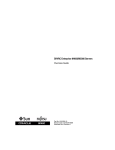
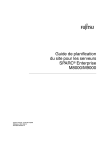


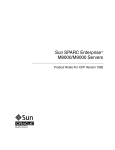
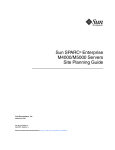
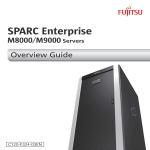
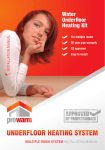
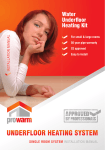
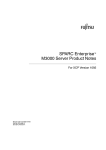
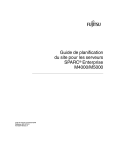
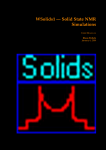

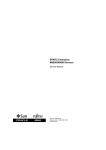
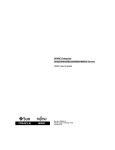
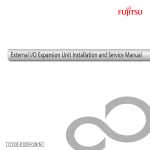
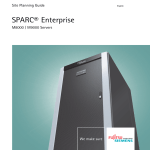

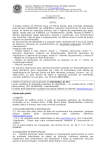
![DLP projectors [v03]](http://vs1.manualzilla.com/store/data/006167278_1-5898e6adff8e3a6708ad6510a0d56014-150x150.png)
